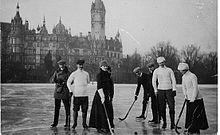Marie Antoinette of Mecklenburg
Marie Antoinette, Duchess of Mecklenburg [-Schwerin], completely Marie Antoinette Margarethe Auguste Mathilde , called Manette (born May 28, 1884 in Venice , † October 26, 1944 in Bled ) was a member of the grand ducal house of Mecklenburg-Schwerin .
Life

.
Marie Antoinette was the younger daughter of Duke Paul Friedrich zu Mecklenburg (1852-1923) from the house of Mecklenburg-Schwerin and Princess Marie zu Windisch-Graetz (1856-1929). Her siblings were Paul Friedrich (1882–1904), Marie Luise (1883–1887), Heinrich Borwin (1885–1942) and Josef (born and died 1889).
Antoinette, usually called Manette, had a tense relationship with her cousin, the ruling Grand Duke Friedrich Franz IV , who in 1906 had her parents incapacitated because of their financial problems and placed under curate.
Antoinette particularly enjoyed and often stayed at Villa Bellevue in Bled . From 1914 to 1918 the Duchess and later her lady-in-waiting Antonia Pilars de Pilar worked with other ladies of the nobility as nurses in various home hospitals.
From Bled, the duchess and her lady-in-waiting traveled all over Europe, especially to Greece and the neighboring Balkan states, until the outbreak of World War II . The duchess was related several times to the ruling houses there, so that there was no need to fear customs or taxes and she was always accepted "en famille". In 1913 they visited, among others, King Nicholas I of Montenegro with Queen Milena in Montenegro .
In 1914 both women stayed in St. Petersburg and were attended by Tsarina Marie Feodorovna for the wedding of "Her Highness the Princess Irina Alexandrovna " with Count Felix Soumarokow-Elston on July 9th . / February 22, 1914 greg. invited to Palais Anitchkow at half past two in the afternoon. To the ball in Palais Anitchkow a week later, on Thursday, July 13th . / February 26, 1914 greg. at half past nine in the evening, a long evening dress with a cleavage had to be worn. During this time, the Duchess and her lady-in-waiting lived with Grand Duchess Maria Pavlovna of Russia , a sister of her father and widow of Grand Duke Vladimir Alexandrovich Romanov . Her aunt was looking for a candidate for Antoinette. Perhaps in honor of the guests from Germany, two performances were given in German on Monday, February 24, 1914 in the Michaeltheater, with a German program leaflet.
When her mother died in 1929, Marie Antoinette inherited her large collection of archaeological finds from her own excavations in Carniola . The Duchess Marie's collection, which filled 72 large boxes, had been confiscated as a result of the First World War and taken to the National Museum ( Narodni muzej Slovenije ) in Ljubljana . In the 1920s, Marie tried to obtain a return by petitioning King Alexander I.
Immediately after Marie's death in July 1929, Marie Antoinette succeeded in getting King Alexander, who was ruling under a royal dictatorship at the time , to have it returned. The National Museum kept a representative cross-section. In 1932 Marie Antoinette gave the collection to the American Art Association auction house , Anderson Galleries, Inc. in New York City for sale. The auction house arranged for a detailed cataloging by a team of leading European prehistorians under the direction of Adolf Mahr . The catalog, which comprises 131 pages, appeared in 1934. At the auction on December 1, 1934, however, there was no buyer for the collection item, which was unusual at the time, who was willing and able to raise the $ 250,000 demanded by Marie Antoinette. Hugo Hencken, director of the Peabody Museum of Archeology and Ethnology at Harvard University , was then able to acquire the part of the Magdalenska Gora inventory, and the Ashmolean Museum in Oxford acquired another part . The remainder was initially kept in stock by Anderson. After the Anderson Galleries went bankrupt five years later, Hencken managed to acquire the rest for the Peabody Museum. They were researched and cataloged there and were last the subject of a special exhibition in 2006.
literature
- Gloria Polizzotti Greis: A Noble Pursuit. The Duchess of Mecklenburg Collection from Iron Age Slovenia. Peabody Museum Press, Cambridge 2006. ISBN 9780873654043 (Peabody Museum Collection Series)
- Bernd Kasten : No prince, nowhere. Duchess Marie Antoinette (1884-1944). In: Ders .: Prince Schnaps. Black sheep in the Princely House of Mecklenburg. Rostock 2009. ISBN 978-3-356-01334-4 . Pp. 89-97.
Web links
- Literature about Duchess Marie Antoinette in the Landesbibliographie MV
- Marie Antoinette Margar. from Mecklenburg-Schwerin
Individual evidence
- ↑ Greis p. 50.
- ↑ Greis p. 50.
- ^ Prehistoric grave material from Carniola excavated in 1905-14 by HH the late Duchess Paul Friedrich of Mecklenburg neé Princess Marie of Windischgrätz. New York: American Art Association, Anderson Galleries, Inc. 1934.
- ↑ See the catalog: Greis.
| personal data | |
|---|---|
| SURNAME | Marie Antoinette of Mecklenburg |
| ALTERNATIVE NAMES | Marie Antoinette Margarethe Auguste Mathilde Duchess of Mecklenburg-Schwerin (full name); Manette zu Mecklenburg (nickname) |
| BRIEF DESCRIPTION | Duchess of Mecklenburg |
| DATE OF BIRTH | May 28, 1884 |
| PLACE OF BIRTH | Venice |
| DATE OF DEATH | October 26, 1944 |
| Place of death | Bled |

